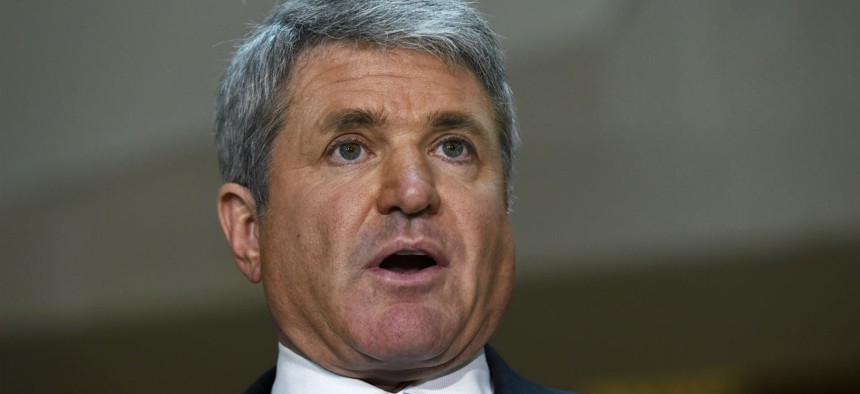
Rep. Michael McCaul, R-Texas, introduced a bill that would offer more flexibility. Susan Walsh/AP
Flexibility or More Money? Lawmakers Push Competing Bills to Help TSA Overcome Long Lines
Bills would attempt to address the wait time crisis.
The top lawmakers with oversight of the Transportation Security Administration want to give the embattled agency more flexibility to move its employees around to deal with its current wait time crisis.
A proposed measure would allow TSA to use employees not typically deployed to screen airport passengers, such as the controversial behavior detection officers, to help expedite the long security checkpoint lines that have resulted from staffing cuts and a spike in airline passengers. Those officers have been criticized for engaging in profiling and resorting to tactics that auditors have said are “the same or slightly better than chance” in detecting security risks.
The Checkpoint Optimization and Efficiency Act, introduced by Rep. John Katko, R-N.Y., who heads the Homeland Security Committee’s panel on transportation security, and Rep. Mike McCaul, R-Texas, who chairs the larger committee, would create a “staffing advisory committee” made up of private stakeholders, airports and government regulators to coordinate the response to current personnel issues.
It would also require TSA to assess its current procedures for allocating staff and share the results of that assessment with airlines and airports. TSA’s federal security directors, who serve as regional overseers, would receive more authority to make staffing decisions. The agency would be able to shift around its canine teams -- already part of its current strategy -- and make agreements with airlines and airports to set their minimum staffing levels.
“Travelers are frustrated with TSA’s bureaucracy -- facing longer lines, and in some cases, missing flights and having to return home or stay overnight in the airport,” Katko said. “This measure provides greater flexibility and accountability to the TSA, allowing the agency to better utilize its personnel by collaborating with local airports and air carriers to ensure that staffing is best allocated at each individual airport.”
McCaul said the bill resulted from local entities asking that TSA delegate more authority to its employees on the ground at the local level.
“This legislation is a critical step towards ensuring that the traveling public receives security screening that is not only effective but also efficient,” McCaul said.
While the measure won bipartisan support, with Reps. Kathleen Rice, D-N.Y., and Bill Keating, D-Mass., signing on, Democratic leaders put forward their own bill to address the TSA predicament. Reps. Bennie Thompson, D-Miss., and Peter DeFazio, D-Ore., ranking members of the Homeland Security Committee and the Transportation and Infrastructure Committee, respectively, said the situation stemmed from a funding shortage.
The 2013 budget deal diverted to deficit reduction a portion of the security fees the agency collects from every ticket airlines sell. The Funding for Aviation Screeners and Threat Elimination Restoration (FASTER) Act -- which also received bipartisan backing -- would restore the $14.2 billion the agency will divert by fiscal 2025 back to the agency.
“The airport security checkpoint wait times crisis did not occur overnight,” Thompson said. “To make sustained and measurable improvements, TSA needs an infusion of resources to be able to invest in its people and technology.”
TSA has seen its budget and workforce slashed over the last several years, though the cuts resulted in large part due to the agency’s self-requested reductions. Through President Obama’s budget, TSA asked Congress for less than it was given in the previous year in fiscal years 2012 through 2015. The agency asked for less money and fewer employees as it expected more passengers to sign up for programs like PreCheck.







